The life and times of Howlin' Wolf
100 years since the birth of a blues legend
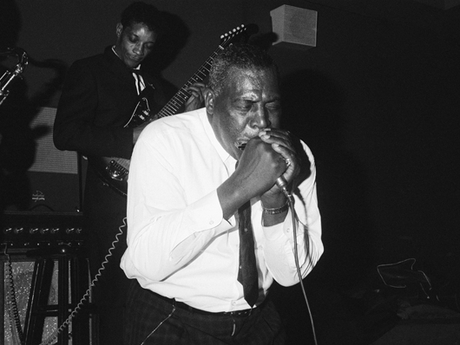
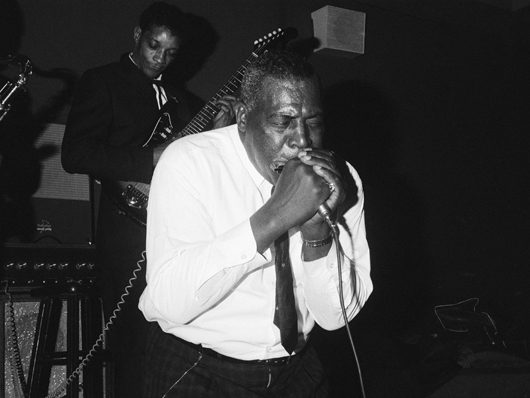
Howlin' Wolf: live in Detroit in the 1960s (Image © Michael Ochs Archives/Corbis)
10 June 2010 would have been Howlin' Wolf's 100th birthday. Although he passed away in 1976, it's impossible to overstate the importance of one of the most influential figures, not only in the evolution of the blues, but in 20th Century popular music as a whole.
Come let us celebrate the anniversary of a true music legend.
1910: A legend is born
Howlin' Wolf was born on 10 June 1910 in White Station, Mississippi. He's still the town's only claim to fame…
… and you thought Howlin' Wolf was his real name. He was in fact born Chester Arthur Burnett. His parents, Leon 'Dock' Burnett and Gertrude Jones, named their boy after Chester Alan Arthur, the 21st president of the United States who had campaigned for the rights of slaves in New York City.
It was Chester's grandfather, John Jones, that kicked off the whole 'Wolf' nickname. He would tell his grandson that the big bad wolf would get him if he misbehaved. When he did cross the line his family would chase after him making howling wolf sounds. The name stuck…
His childhood hero was Jimmie Rodgers. Also known as the Singing Brakeman, the Blue Yodeler and the Father of Country Music, Rodgers sang white boy blues before they called it country.
Get the MusicRadar Newsletter
Want all the hottest music and gear news, reviews, deals, features and more, direct to your inbox? Sign up here.
Wolf was a big lad. At his, er, height he stood six feet threeinches tall in his stockinged feet and weighed almost 300 pounds. You would not want to spill his pint.
Wolf's mother was a real piece of work. She threw him out of the house when he was still a cub, forcing him to hike barefoot over frozen ground to his great uncle Will Young's house many miles away. Turns out it was your classic frying pan/fire scenario as Young was no picnic either... he was once described as 'the meanest man between here and hell.'
At the height of his success Wolf tried to reconcile with his mother. Offering her money, she took the cash and stamped it into the ground. She didn't want anything to do with his 'Devil music.' Lovely…
Next: Time to buy a guitar…
1920s: First guitar bought…
At the age of 13 Wolf runs away from his uncle Will Young's place and eventually finds his father. He settles down to a life of hard graft in the fields.
Howlin' Wolf was not Chester's only nom de plume. According to Ted Gioia's excellent book Delta Blues, in the '20s, Wolf was also known as John D, Foots, Bigfoot, Buford, Bullcow or John D. Burnett.
Thanks to a great crop the year before Wolf has the money to buy his first guitar... on January 15 1928. It's a date that Wolf never forgot til the day he died.
1930s: First song learnt…
Howlin' Wolf was mentored by Delta bluesman Charley Patton. The pair met in 1930. Not only did Patton teach Wolf guitar he taught him about showmanship: "When he played his guitar, he would turn it over backwards and forwards, and throw it around over his shoulders, between his legs, throw it up in the sky," said Wolf of his tutor years later.
He learns his first song, Charley Patton's Pony Blues. Wolf: "The first piece I ever played in my life was a tune about hook up my pony and saddle up my black mare."
Wolf was taught how to play the harmonica by Sonny Boy Williamson in 1933. Incidentally, there were two blues artists called Sonny Boy Williamson. The fella that taught Wolf to blow harp was Aleck 'Rice' Miller aka Sonny Boy Williamson II. Miller wrote the classic Eyesight To The Blind, later covered by The Who and Aerosmith.
Wolf makes his bones with legends in the 1930s. Over the years many bluesmen claimed to have known and played with Robert Johnson. Howlin' Wolf actually did. He also played juke joints with Son House, Johnny Shines, Honeyboy Edwards and Willie Brown… Delta blues royalty to a man.
Next: Signing up, gettin' married
1940s: In the army now
Wolf is inducted into the US army in early 1941, about eight months before the Japanese get medieval at Pearl Harbor…
It's autumn 1943 and Wolf is in a military hospital near Portland, Oregon. By November 3 that year he is given an honourable discharge from the US army. He returns to farm labouring.
Wolf gets hitched to his first wife Katie Mae Johnson on May 3, 1947. Yes, 'first wife' suggests that the relationship might not have gone the distance. They split when Wolf later moved to Chicago. She died a few years later.
In 1948, Wolf was to be found in West Memphis, Arkansas, on the other side of the river from Memphis, Tennessee. He immediately sets to work assembling his own band that includes blues luminaries like Matt 'Guitar' Murphy (later a member of The Blues Brothers Band) and harmonica player Junior Parker. While in West Memphis, Wolf bags himself a slot on local radio station KWEM playing music and plowing through advertisements for farming equipment.
1949: Wolf's father, Leon 'Dock' Burnett, dies. Possibly as a result, Wolf appears to intensify his efforts to be a successful performer and recording artist.
Next: Time to get paid
1950s: Here comes the Sun
1951: Sam Phillips, the owner of Sun Studios at 706 Union Avenue in Memphis, puts the word out that he's interested in recording Howlin' Wolf after being given a tip-off about him by a local DJ. Sun Studios, originally called the Memphis Recording Service, will eventually become the birthplace and home of rockabilly in the mid-'50s.
1951: Wolf cuts two recordings for Sam Phillips on 14 May: Moanin' At Midnight and How Many More Years. Phillips would describe Moanin' At Midnight as a 'classic thing that nobody can improve on.'
He would receive more high praise from the 'Kingmaker.' Years after working together, Sam Phillips claimed that Howlin' Wolf had the greatest talent of all the artists he worked with. Remember those artists Phillips worked with include Carl Perkins, Johnny Cash, Jerry Lee Lewis and a local truck driver with swiveling hips called Elvis Presley.
Moanin' At Midnight and How Many More Years are leased to and released by Chicago's Chess Records as a double A-side single. By Autumn 1951 they are in the top ten of the Billboard R&B chart.
1954: Thanks to the success of his Chess singles, Wolf makes the decision to move to Chicago. In typical Wolf fashion he decides to do it in style. No hitchhiking or dossing in the hobo jungles for him. Instead, he drives a two-tone DeSoto sedan along Route 61 to Chicago with over $4000 in his pocket. When he arrives in Chicago he begins his legendary rivalry with Muddy Waters.
One of the reasons that the rivalry between Muddy Waters and Howlin' Wolf was so strong was that they were both receiving songs written by blues genius Willie Dixon. Muddy performed Dixon songs like I Just Want To Make Love To You and Hoochie Coochie Man; Wolf powered his way through Dixon classics like Little Red Rooster, I Ain't Superstitious and Evil. Wolf was always suspicious that Dixon was giving his best songs to Muddy, which stoked the rivalry between the two artists even more.
1954: Guitarist Hubert Sumlin arrives on the scene. Sumlin would be Wolf's guitarist and right hand man pretty much solidly until Wolf's death in the '70s. Check out this classic clip in which Sumlin, backed by an all-star band, teaches you how to play Smokestack Lightning. Of course, Howlin' Wolf would not be the only blues giant that Hubert worked with in his illustrious career. He also contributed his stellar guitar skills to the 2006 album Mojo Priest by Steven Seagal. Did that sound sarcastic?
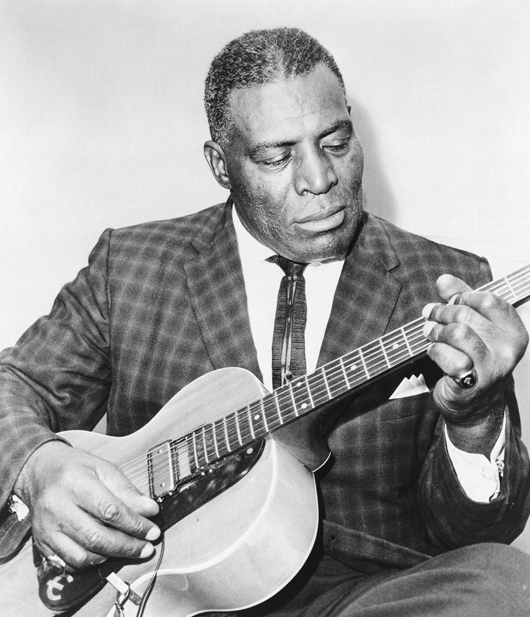
Classic bluesman-with-guitar pose: Howlin' Wolf from 1955 (image © Michael Ochs Archives/Corbis)
Get your Coke out. Wolf was the consummate showman. Not only would he crawl around on all fours onstage, he would persuade his female fans to clamber on his back for a quick joyride. After releasing Spoonful he would brandish a large cooking spoon around onstage in a manner that would even make Nigella Lawson blush. His funkiest trick however was when he would shake up a bottle of Coke, pop it down his trousers, poke it out of his fly and spray the foam over the audience. Come again?
The blues legend does evening classes in reading, writing and maths. In the '50s Howlin' Wolf wanted to get a belated education. "I am not a smart man," he once said. "I don't have no education see... Now, you can take my sense and put it in a paper bag and it'll rattle like two nickels."
1957: Meets Lillie Handley Jones at one of his shows. He likes what he sees...

Moanin' In The Moonlight (1959): Features the immortal I Asked For Water (She Gave Me Gasoline)
1959: Chess release Wolf's first album, Moanin' In The Moonlight. The record is a compilation of singles released by Wolf in the '50s. It includes the tracks he recorded for Sam Phillips at Sun and Smokestack Lightning, his classic 1956 release. The album is a blues masterpiece... an essential purchase.
Next: Time to get famous
1960s: Mick and Keef make a request
1962: Wolf's second album Howlin' Wolf is released. It is a collection of six singles previously released by Chess from 1960 through 1962.
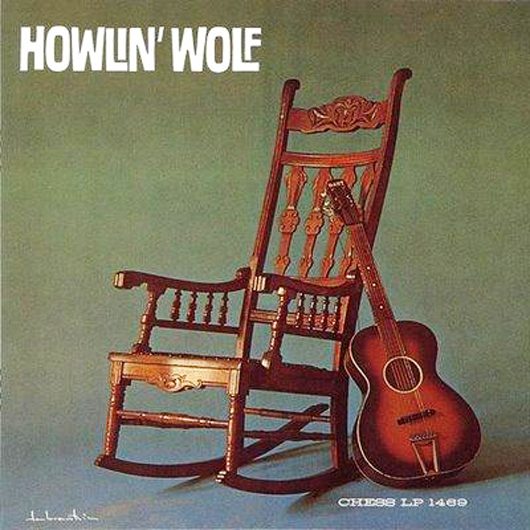
Howlin' Wolf (1962): Known (and eventually reissued) as The Rockin' Chair Album
May 1964. Wolf ties the knot with his second wife Lillie. He tells his new bride, "I wish I'd had you the first day I ever howled." Sweet. This marriage lasts.
1964: Another Wolf album Rocking The Blues - Live In Germany is released.
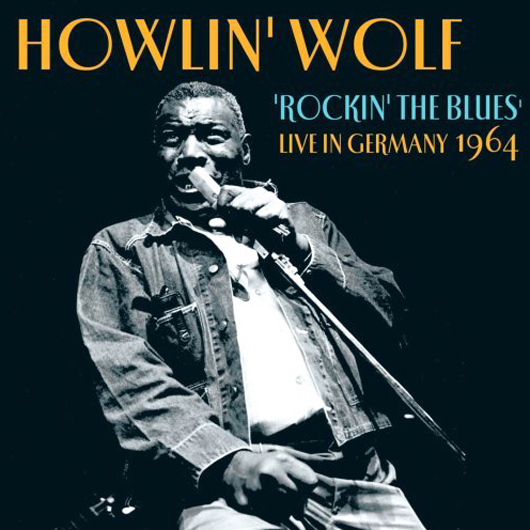
Rockin 'The Blues (1964): Lookin' cool, soundin' righteous
It's May 26 1965, The Rolling Stones appear on season 1, episode 41 of Shindig! While the band play songs like Little Red Rooster, The Last Time and Play With Fire (and a finale run through of (I Can't Get No) Satisfaction), it's their insistence that Howlin' Wolf also perform on the show that makes the event so special. Wolf romps through his Sun recorded, Chess released classic How Many More Years...
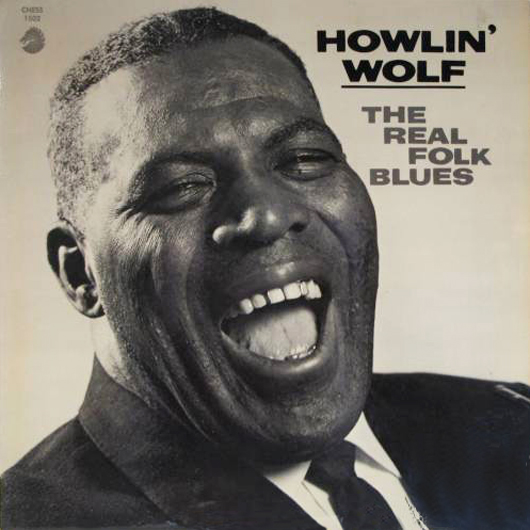
Wolf lets loose with The Real Folk Blues (1965)
1965: Chess release The Real Folk Blues, one in a series of compilation albums from popular bluesmen. Howlin' Wolf, Sonny Boy Williamson II, John Lee Hooker and more get their own dedicated releases.
1966: Newsweek publish a profile of Howlin' Wolf in its February issue. The blues revival is now officially underway in the USA.
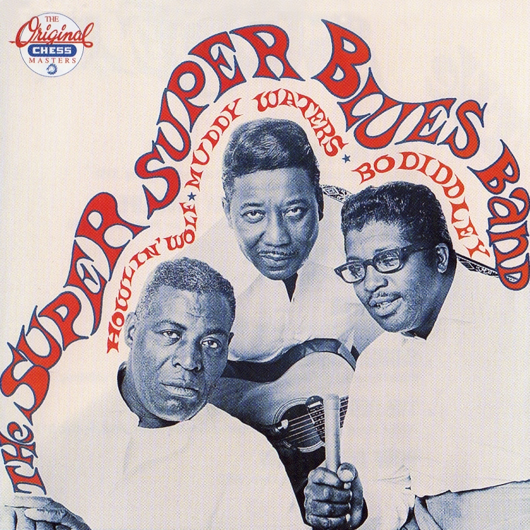
Wolf, Bo and longtime rival Muddy pose for the classic Super Super Blues Band (1966)
1966: A pair of Wolf albums, Live In Cambridge and The Super Super Blues Band, are released.
The Doors record their version of Wolf's Back Door Man in August 1966. It's released on the band's eponymous debut album in January 1967, natch.
Howlin' Wolf used a bunch of different guitars during his career including Harmony steel-strung acoustics and, in the '60s, an Epiphone Casino. He's also been pictured with a white '60s-era Fender Stratocaster.
1967: Chess release another Wolf compilation called More Real Folk Blues.
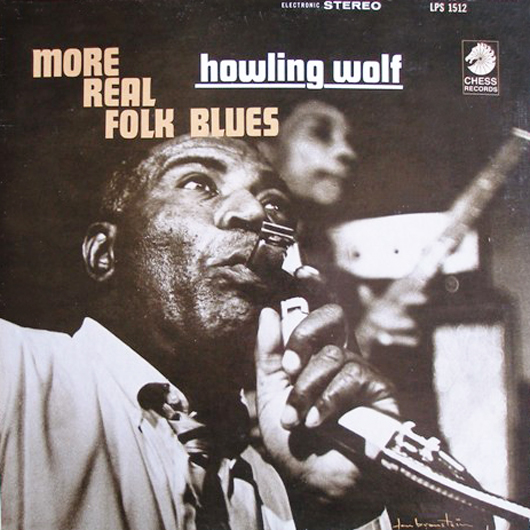
Nuthin But A G Thang: More Real Folk Blues is erroneous credited to Howling Wolf
1969: His first heart attack. Travelling to a show at the University of Chicago, Wolf suffers a heart attack, falling against the dashboard of the car he's in. Hubert Sumlin, who was driving, pulled over then grabbed a two-by-four that was lying on the road. In a moment of inspired desperation Sumlin rammed the piece of wood into Wolf's back, kick starting the big man's heart.
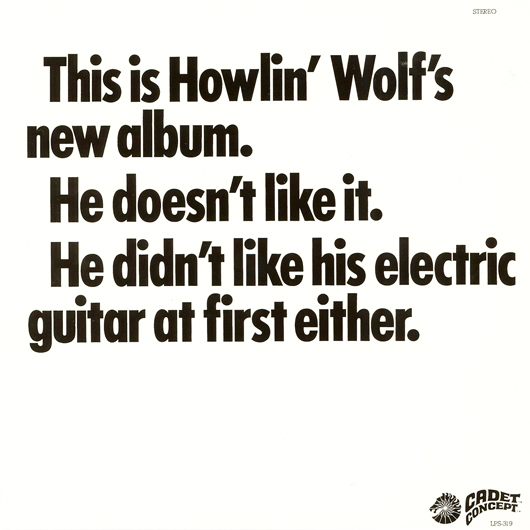
"Dog shit" or not, The Howlin' Wolf Album has achieved cult status amongst collectors
The infamous Howlin' Wolf album is released in 1969. The record was an attempt by Chess Records to update Wolf's sound with some Hendrix-style histrionics. It falls flat, big time. It's so bad in fact that Wolf himself referred to it as "dog shit." Amazingly, Chess exploited the artist-hates-his-own-record angle, placing a negative statement on the cover - see cover above. Funnily enough, the album bombed. Chess had tried to update Wolf's old rival Muddy Waters in the same way the year before with the album Electric Mud. Muddy hated his pimped out album too.
Next: Howlin' to the end
1970s: Howlin' to the end
1970: Wolf appears on the cover of the first issue of Living Blues Magazine, the longest running publication dedicated to blues music. It's still going strong.
1971: The London Howlin' Wolf Sessions album is released. Recorded during sessions that took place between May 2 and May 7, 1970, the album features among others Eric Clapton, bass player Bill Wyman and drummer Charlie Watts of The Rolling Stones and Beatle Ringo Starr.
1971: Wolf's Message To The Young album is released.

One of the last great Wolf releases: Message To The Young (1972)
1972: Howlin' Wolf receives Honorary Doctor of Arts Degree from Columbia College, Chicago.
1973: Wolf records and release his last studio album Back Door Wolf. The album features the up-to-the-minute rant of Watergate Blues.
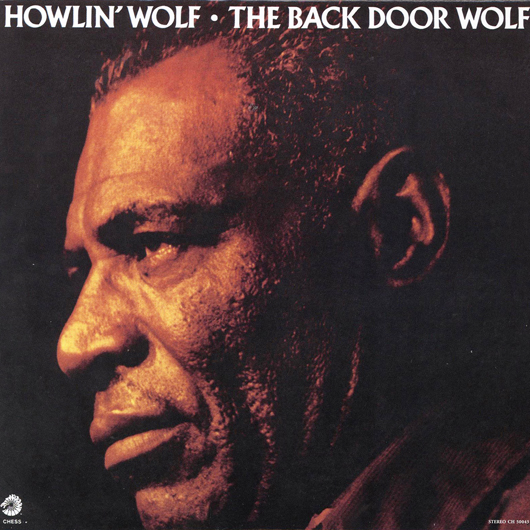
A bluesman in portrait: The Back Door Wolf (1973)
1974: London Revisited, an archive plundering exercise by Chess Records is released. The album brings Wolf and Muddy Waters together on the same album with outtakes from both men's London sessions. Not essential, but interesting to completists.
1975: Wolf receives Montreux Festival Award for his album, The Back Door Wolf.
November 1975: With his health deteriorating Wolf makes his last public appearance with B.B. King at the Chicago Amphitheater.
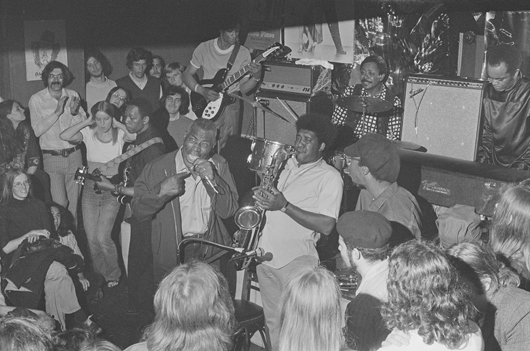
1973: Live and laughin' in Cambridge, MA (Image © Jeff Albertson/CORBIS)
January 10, 1976: Howlin' Wolf dies at Hines VA Hospital in Hines, Illinois. A combination of a brain tumour, kidney disease and heart failure silences the great man for keeps. If you wanna go pay your respects, Wolf is buried in Oak Ridge Cemetery, Hillside, Cook County, Illinois in a plot in Section 18, on the east side of the road. Rumour has it that Eric Clapton paid for his gravestone.
Next: the legend lives on
1980s and beyond: The legend lives on
1980: Howlin' Wolf is posthumously inducted into the Blues Foundation's Hall of Fame.
Wolf is inducted into the Rock & Roll Hall of Fame in 1991 and the Hall of Fame in his hometown of West Point, Mississippi in 1995.
The Howlin' Wolf Blues Society is formed in 1996. The first annual Howlin' Wolf Blues Festival was held in West Point the same year. It's now held every year in August.
2003: The Howlin' Wolf Story - The Secret History of Rock & Roll documentary film is released.
2008: Frank Zappa's Jukebox, a compilation of tracks that inspired Zappa is released. The album features Wolf's I Asked For Water (She Gave Me Gasoline).
2008: Wolf is portrayed by Brit actor Eamonn Walker in the movie Cadillac Records, the story of Leonard Chess, founder of Chess Records.
There are a couple of great books about Howlin' Wolf: Moanin' at Midnight: The Life and Times of Howlin' Wolf by James Segrest and Mark Hoffman; Delta Blues by Ted Gioia features a bulging chapter on the great man. We'll let the great man himself have the last word:
Liked this? Now read: A-Z of the blues
Connect with MusicRadar: via Twitter, Facebook and YouTube
Get MusicRadar straight to your inbox: Sign up for the free weekly newsletter









